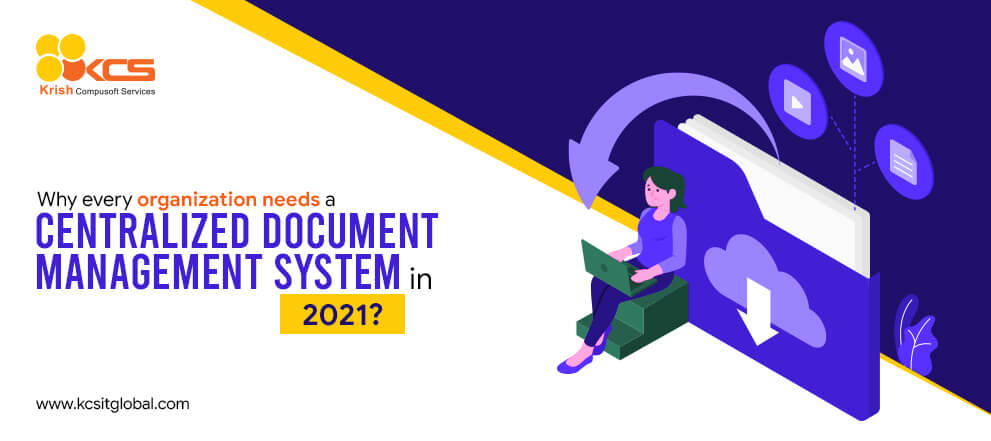
Category: Hi-Tech
Why every organization needs a centralized document management system in 2021?
Documents, whether electronic or paper, are one of the most important components in every enterprise. Managing business data, occasionally from various resources can be a daunting task. Depending on the nature of your organization, a centralized document management system that gathers, stores, and retrieves paper, as well as electronic documents, can deliver multiple key benefits to your business.
The primary key to enhancing productivity and efficiency in a business lies in finding ways to provide centralized document access to all your employees. The more readily available client and business data are for key stakeholders, the smoother the process for all involved. One of the major disadvantages of physical paper is that it seems impossible to track down particular information. It might be on an employee’s desk, misfiled, or simply lost among the stacks of paper. But with a centralized document system, everyone goes to one place to find the information they need. In simple terms, a centralized document management system enables enhanced efficiency along with slip-through-the-crack mistakes.
According to the Mordor Intelligence study, the global document management system market is valued at USD 4.86 billion in 2019 and is estimated to grow up to USD 10.17 billion by 2025, recording a CAGR of 13.04% between 2020 and 2025.
A Centralized document repository cuts costs by uniting various concepts, technologies, and strategies to eliminate tedious and time-consuming operations that do not drive revenue. Generally, centralized document management automates previously manual duties like managing financial compliance records.
Top 3 benefits centralized document management system offer to a business:
1. Enhanced data security:
A recent report by IBM and Ponemon Institute states that a data breach could cost an enterprise on average $2.64 million. Still, several businesses leave data exposed to theft or tampering. For instance, storing sensitive data in unsecured folders open to the entire network, keeping files on a less secured device that are open to hacking, or even simply leaving documents unattended.
A centralized document repository system prevents unauthorized access to data with the help of role-based access control.
This means employees can only access and update only those documents about their particular role, and which managers have assigned them permission to work on. A centralized document management system also stores all the changes made to the document, hence, in the event of tampering, you can see exactly who was responsible. Disaster recovery is also much easier, as all the documents are backed up to the system, assuring nothing important is lost.
2. Simplified workflows:
In enterprises, versioning problems occur daily. A centralized document repository secures versioning mix-ups that can occur when various employees store the same file in multiple locations, by allowing them to collaboratively work on the same document simultaneously. This assures everyone is working on the most updated file, and the time that is consumed in forwarding documents and talking through changes can rather be navigated to more valuable activities.
A centralized document management system can also provide version control, enabling older versions of the documents to be recovered in the event incorrect or unauthorized changes were made in it. Moreover, a centralized document repository can help you in automating workflows by reorganizing document types and assigning the relevant workflow template. This increases the document processing and is immediately directed to the next employee in the chain once it is processed. All of these are done without anyone having to get up from their desk, saving time, and reducing processing errors like multiple data entry.
3. Significant cost-savings:
On the contrary to being environment friendly, shifting toward becoming a paperless enterprise directly affects the bottom line. Also, consider all the room that is needed to store all the papers. Huge filling drawers and cabinets take up significant office space, and this operational cost only increases yearly as the documents pile up. In a survey conducted by AIIM, respondents predicted that shifting to an electronic filing system will reduce the office space allocated to filling storage by 60%.
Top 4 estimated trends to revolutionize the centralized document management community in 2021.
1. Rise in cloud storage:
Cloud computing has transformed the IT sector and has also created a huge impact on centralized document management systems, and is not going anywhere. Using cloud computing technology, you don’t have to be on a particular computer or have access to a closed network to retrieve your files and documents; the only thing you need an internet connection. The cloud assure documents are available 24/7. A study conducted by McAfee shows that 87% of enterprises encounter business acceleration from their use of cloud services. Besides, businesses are over 35% more likely to release new products, boost their time to market, and expand to new industries when they use cloud computing services.
There is no need to hire professionals to handle your data, your cloud provider is completely responsible for accessibility, responsibility, backups, disaster recovery, and server maintenance. Cloud storage is still developing and continues to make an easier and more accessible data management process. Because of their growing popularity, these technologies are not going anywhere anytime soon.
2. Online security:
In direct correlation with the rise of cloud storage has come an enhancement in document security. Due to significant growth in digital document management, cyber-threats have become more and more sophisticated. This results in a rise in online security options. There is a thin line between the user-friendliness of a centralized document repository system and the vulnerabilities it creates. This means assuring your business content is secured will be a major trend going into 2021.
McAfee's report founded that 52% of companies experience better security in the cloud than in on premise IT infrastructure. This is mainly because security is developed into these systems. Using processes such as role-based permissions, digital archiving, and automated backup plans, your documents are safer than ever. With the implementation of a centralized document management system, your business will have a simplified, highly secured system with scalable storage space and a wide range of features and capabilities.
3. Enhanced affordability:
The rise of the adoption of centralized document management systems has created a more competitive market, which is always profitable for consumers. Modern centralized document repository system was once so expensive that several enterprises tend to avoid it. Cloud computing and other latest technologies have made it possible to buy cutting-edge centralized document repository system without compromising the budget. Hence, there are more sophisticated solutions available at an affordable price.
Also, to lower the costs, a centralized document repository system is saving enterprises’ more money. A document management system is a tool that can completely modernize your manual processes. Digitizing documents and managing electronic documents enables businesses to eliminate paper storage, simplify operations, and enhance communication.
Companies will receive the benefits of this and increase efficiency by moving resources from clerical tasks to revenue-producing ones. By eliminating extra hires, reducing time spent on filing and finding missing documents, and enhancing overall business performance, a centralized document management system can now save your organization more money than ever before.
How centralized document management systems are impacting various industries?
1. Human Resources:
Human resources’ administrative operations are time-consuming and labor-intensive when they are paper-based or dependent on disjointed technologies such as Excel spreadsheets, shared drives, or software that cannot share data. With office automation in your office, you and the HR team can concentrate on strategic problems such as employee engagement, preserving the safeguarding of the company culture by organizing events and training, and providing a quick response to workplace issues as they occur.
A centralized document management system secures employees to document and files in an encrypted repository and preserves them with controlled access rights. Employees working from home can get quick access to benefits information containing healthcare and childcare flexible spending accounts, time-off requests, and employee assistance programs. Both employees and the HR team can access document and workflow status, and individual records remotely. Employee self-service and quick response time to requests for information saves time and effort of staff and for you as well.
2. Healthcare:
In the United States, administrative costs in the healthcare sector account for more than 25% of total expenses. A large portion of this expenditure is one on paperwork associated with billing, records, coding, and insurance. Each extra visit adds to the volume. Also, hospitals and clinics have to store all the records for a minimum of 10 years after a patient’s final visit. Digitalizing patient records and implementing a centralized document management system has several benefits over conventional paper-based solutions.
When a patient is hospitalized, finance and billing are some of the most stressful aspects. The sooner and more accurately patients’ claim forms are submitted, the better and faster they get to know what they are against on the financial front. When all the departments in a hospital have access to the same patient files, it can make various aspects of care consistent. Generally, doctors and nurses verify all the information with the patients, but not all everyone is in a condition to narrate every detail all the time.
3. Finance:
According to Forbes, banking is one of the major industries with robust growth potential when it comes to IT investment. Every day, hundreds and thousands of transactions are carried out and the efforts they make to optimize their operations. Despite the breakthroughs in data management and transmission, a lot of internal and external communication among banks and customers are still conducted on paper. These confidential documents are generally stored using outdated document management software with limited accessibility options.
Hence, managing documents carefully has become one of the top priorities for all the banks. Whether driven by simplifying core processes or satisfying enterprise-specific requirements, adopting a centralized document repository is important for the smooth functioning of any banking organization. Maintaining and sharing millions of documents like statements and notifications entail a high cost for financial entities. Using a centralized document management system, they will be able to reduce this cost significantly.
Banks carry out internal and external audits to assure that they adhere to the appropriate regulations and keep an accurate record of all financial transactions. These audits are conducted in a more effective and error-free way when a powerful centralized document repository is used which makes it easy to monitor all transactions conducted with a certain type of data.
4. Education:
Document management is one of the areas where artificial intelligence has created a significant positive impact on education. Administrators and professors encounter a colossal amount of data, documents, and student records. All of this information needs to be organized and secured. Privacy of student data is essential by law; hence, a centralized document management system must be fully docile and with all relevant regulations.
Modern document management software is equipped with AI which can help you in managing records efficiently. Powered by machine learning, this software can handle a large volume of documents. These technologies allow better reporting as well. Using monitoring data, AI programs can identify trends and patterns that help education institutes in the decision-making process.
KCS capabilities in centralized document management
The primary motto of KCS is to serve our client with the best technological solution and offer modern generation software solution. Our team of highly qualified experts has developed an enterprise social network, information management and collaboration platform, iNet. It helps enterprises in connecting and engaging their workforce internally and globally. iNet also learns how your organization works and help you establish a productive and informed workplace. Our powerful centralized management system brings all the information, tools, and application at one place and gives outstanding employee experience. Content management, employee directory, document, social network, iNet has got everything covered.
Recent posts
-
KCS Joins Forces with Biarca on Cloud Security, Announces Completion of Strategic Acquisition
March 30, 2022
-
Krish Compusoft Services (KCS) appraised at (CMMI)® Maturity Level 5
November 04, 2021
-
KCS commemorates its 20th anniversary with a series of exciting activities and announcements
August 15, 2021
Articles
-
How Utilities are Adapting to the ‘New Normal’ Post Pandemic in the Realm of Customer Experience (CX)
February 02, 2022
-
How Enterprise Logic Apps Create Business Value for Azure Users
November 15, 2021
-
Accelerate Your Journey To Smart Manufacturing Transformation - The Ecosystem Approach
October 26, 2021










